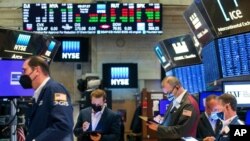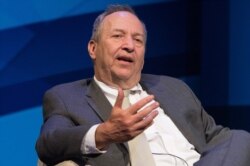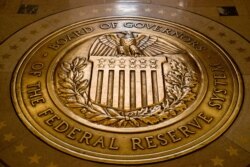In the week since the U.S. Department of Labor announced a surprisingly high rate of inflation for April, officials at the Federal Reserve and Treasury Department have been fighting hard to prevent fears of rising prices from infecting the financial markets. It’s a fight they appear to be losing.
Stock markets tumbled Wednesday as the U.S. financial press was full of comparisons of the current economic situation to the late 1960s, when an overheated U.S. economy ushered in a decade of painful price increases beginning in the early 1970s.
The consequences of a repeat of the 1970s would not be limited to the U.S. To fight inflation, the Fed would tighten the money supply by scaling back on asset purchases and raising interest rates. This could be bad news for some developing countries, because it would draw investment capital back to the U.S. But for countries that export to the U.S., it would be good news — a stronger dollar would make imports cheaper and more attractive to U.S. consumers.
Harsh criticism for Fed
Prominent figures from outside the government, including former Treasury Secretary Larry Summers, have been blasting the Fed for days over the central bank’s promise to keep interest rates low for the foreseeable future and to tolerate what Fed policymakers say will be a temporary increase in inflation as the U.S. economy revs back up following the pandemic recession.
At the heart of the argument is a battle over what the bigger risk is: slowing the economic recovery too soon and leaving some Americans behind, or waiting too long to reel in a booming economy and suffering inflation that may be hard — or impossible — to control.
When the Fed released the minutes from the April meeting of its Federal Open Market Committee on Wednesday afternoon, central bank watchers reading the tea leaves found some small indication that the FOMC is at least aware that tightening monetary policy may be necessary in the not-too-distant future.
“A number of participants suggested that if the economy continued to make rapid progress toward the Committee’s goals, it might be appropriate at some point in upcoming meetings to begin discussing a plan for adjusting the pace of asset purchases,” the minutes said.
Fighting the last wars
The two sides in the argument over the direction of the economy can both point to historical evidence to bolster their cases.
“I like to say that everybody in this game is fighting the last war, but they're all fighting different last wars,” said David Wessel, director of the Hutchins Center on Fiscal and Monetary Policy at the Brookings Institution in Washington.
The Federal Reserve Board comes to the current moment after a decade in which inflation has barely budged, whether the economy was booming or in recession. And with millions of Americans still out of work, the central bank is reluctant to put the brakes on the economy in the name of protecting it from a danger that hasn’t reared its head to any significant degree in years.
“The Fed is trying to assure people that they're not going to prematurely raise interest rates and cut off the recovery before we get to full employment,” Wessel said. “They're saying that we're essentially willing to take a risk here, that we will get a little more inflation than we want in order to get a little more employment.”
A more traditional view of inflation
Fed critics like Summers are taking a more traditional view of the threat of price inflation, noting that in the past, once inflation has begun, it has historically been very difficult for policymakers to rein it in without resorting to what amounts to a self-made recession.
"Larry Summers is saying, ‘I look at history. And I think that the relevant period of history is not what we were seeing just before the pandemic. It's episodes like the late '60s and early '70s, when we just ran the economy too hot and got inflation out of control,’” Wessel said.
Inflation averaged 7.1% per year in the 1970s, but spiked into double digits in both 1974 and 1979. Americans living on fixed incomes, such as retirees on pensions, saw their spending power slashed as prices for everything from food to fuel to rent got more expensive. Between 1970 and 1980, the median price of a home in the U.S. nearly tripled.
Summers brought his criticism right to the Federal Reserve system itself this week. In remarks Tuesday at an event hosted by the Federal Reserve Bank of Atlanta, Summers warned that the Fed’s suggestion that it would hold off on raising interest rates indefinitely is creating a “dangerous complacency” that ignores what he believes are the more serious risks.
“The primary risks today involve overheating, asset price inflation, and subsequent financial excessive leverage and subsequent financial instability,” he said. “Not a downturn in the economy, excessive unemployment and excessive sluggishness.”
Avoiding the self-fulfilling prophecy
When central bankers discuss inflation, they often speak not of inflation itself, but of “inflation expectations.” This is because businesses’ and consumers’ beliefs about what inflation will look like in the future often feed into actual inflation. A company that expects its costs to increase will preemptively raise its prices, contributing to the very inflation it is worried about.
Kenneth N. Kuttner, a professor of economics at Williams College in Massachusetts and a former assistant vice president at the Federal Reserve Bank of New York, said that one reason the Fed seems less concerned than Summers is that the central bank appears to believe it has “anchored” the markets’ expectations.
For some time, the central bank has said that it will use the tools at its disposal to keep inflation in the range of 2% per year.
“They think they’ve built up credibility for that target over the years,” Kuttner told VOA.
“In their view, if inflation goes above that for a little bit, people's expectations won't rise very much,” he said, “and you won't get that same kind of inflationary spiral you got in the 1970s, when inflation expectations were not anchored, and people didn't believe that the Fed was going to bring inflation back to any particular target.”












